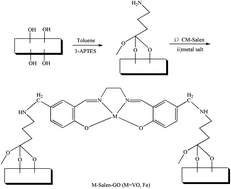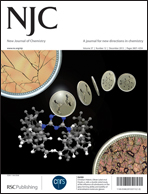Oxovanadium(iv) and iron(iii) salen complexes immobilized on amino-functionalized graphene oxide for the aerobic epoxidation of styrene
Abstract
Oxovanadium(IV) and iron(III) salen complexes grafted onto amino-modified graphene oxide (NH2–GO) have been synthesized via a stepwise procedure and the prepared materials were used as heterogeneous catalysts in the aerobic oxidation of styrene. The structures of these materials have been thoroughly investigated using different characterization techniques such as XRD, N2 adsorption–desorption, TEM, FT-IR, diffuse reflectance UV-visible spectroscopy, ICP-AES, TEM, TG, Raman, and XPS. The results of XRD, N2 adsorption–desorption and TEM revealed that the structures of the prepared catalysts were well preserved. In addition, the results of FT-IR, diffuse reflectance UV-visible spectroscopy, ICP-AES, TG, Raman and XPS suggested that the oxovanadium(IV) and iron(III) complexes had been incorporated onto amino-modified graphene oxide (GO). It was found that the heterogeneous oxovanadium(IV) catalyst was more active than its homogeneous analogue in the epoxidation of styrene, using acetonitrile as solvent and air as the oxidant in combination with the sacrificial co-reductant isobutyraldehyde, due to site-isolation. Furthermore, the tethered vanadium catalyst was quite stable and could be recycled many times.


 Please wait while we load your content...
Please wait while we load your content...